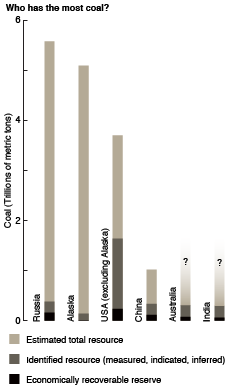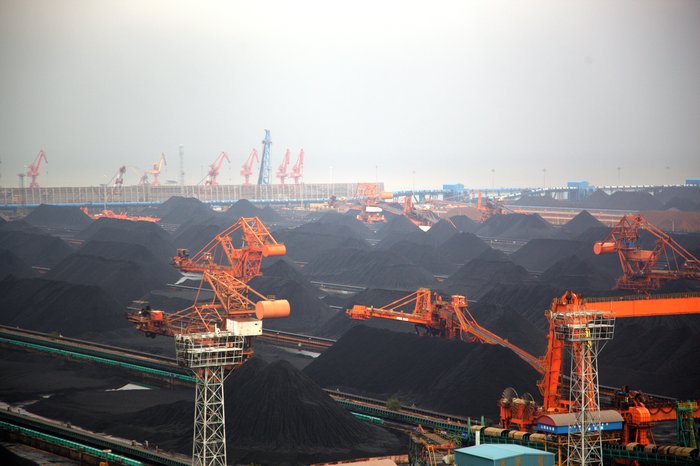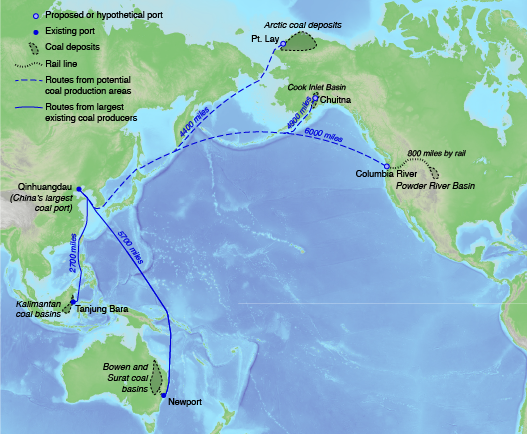Alaska Coal Resource: Potential for future development
Last modified: 12th August 2019

- Economically Recoverable Reserves
- Identified Resource
- Total Resource
- Could Alaska compete in the Pacific coal market?
- Sidebar: Coal and CO2
- How much CO2 would be released if this coal was burned?
- Summary
How much coal is in Alaska? Industry and environmental groups in the state often make incredible claims: Alaska has a tenth, an eighth, or even as much as a fifth of the world’s coal.

To answer this question, the meaning of “how much” must be defined. Because coal hasn’t been mined extensively in Alaska, it has been much less studied than most coal-rich areas of the world. This means that Alaska’s “recoverable reserves” and “identified resource” - both quantities that are based on dense data from boreholes or documented outcrops - are currently almost unknown. However, a careful analysis of the data that is available for Alaska by the US Geological Survey shows that the total resource in the state is gigantic (Fig. 1). There aren’t similarly careful estimates of total resource for the other major coal-producing areas, but the data that is available suggests that Alaska could possess more coal than those areas.
Alaska’s coal is little studied, and there is little infrastructure to support coal mining. If these changed, Alaska might take advantage of its proximity to East Asia and become a major player in the Pacific coal market.
Unfettered development of Alaskan coal could dramatically increase global greenhouse gas emissions. If the total resource estimates made by the US Geological Survey (USGS) are indeed representative of a large potential reserve, over 500 billion tons of coal might be mined in Alaska. If that amount of coal was then exported and burned, this would contribute over 800 billion tons of CO2 to the atmosphere - enough to shift the climate well beyond an internationally identified 2° C warming limit.
How does the coal in Alaska compare to the 5 countries with the largest coal reserves?
Economically Recoverable Reserves
The most reliable numbers are “recoverable reserves” (the lowest bar in Figure 1). This term refers to the amount of coal that might reasonably be expected to be mined and used out of all the coal known to exist in a given region. For coal to count as part of recoverable reserves, it must first be well-studied, with densely spaced boreholes or documented outcrops. Also, it must be economically feasible to extract it with current technology.
Recoverable reserves are reported by various governments to the World Energy Council (WEC) and then are compiled into various reports. The most recent data comes from the “World Energy Resources 2010” report by the WEC (see “recoverable reserves” in Table 1). These numbers are watched closely by governments, investors, and the coal industry, and they are generally considered to be of high confidence. While the US has around 22% of the world’s recoverable reserves, only about 1% of that is in Alaska, less than 3 billion tons.
These numbers don’t tell us how much coal is in Alaska, or even how much coal is likely to be mined over a long timeframe. If coal exploration in Alaska expanded, and if new coal extraction techniques like underground coal gasification came online, recoverable reserves could increase greatly.
Resource and reserve estimates for countries with largest reserves
| Total resource | Identified resource | Recoverable reserves | |
|---|---|---|---|
| Russia | 5.58 | 0.38 | 0.157 |
| Alaska | 5.10 | 0.14 | 0.003 |
| USA (not AK) | 3.70 | 1.64 | 0.237 |
| China | 1.02 | 0.33 | 0.114 |
| Australia | ? | 0.31 | 0.076 |
| India | ? | 0.29 | 0.061 |
Table 1 : Total resource, identified resource, and recoverable reserves in trillions of metric tons in Alaska and the five countries with the greatest recoverable reserves. (Data plotted in Figure 1. Sources are described in the text.)
Identified Resource
“Identified resources” (middle bar in Figure 1) refer to coal that is both demonstrated by direct measurement (i.e., visual observation, boreholes, or actual mining) and by reasonable geologic assumptions, and also inferred based on the assumed continuity of coal beds. They do not take economic feasibility or technology into consideration. These estimates are made much less frequently and don’t carry the same official status as recoverable reserves.
As shown in Table 1, Alaska still has a relatively small amount of identified resource (140 billion tons) but the rest of the US has a much larger amount (1.6 trillion tons). While these estimates were both made by the USGS, the Alaskan figure dates from 2005while the larger US number goes back to1975. Differences in methodology and semantics make this comparison uncertain.
Due to wide variations in age and methodology between countries, the estimates in Table 1 are not necessarily measuring the same things. The estimate for Russia comes from a 2002 report examining coal resources in the former USSR, referencing data from the late 1980s. Our estimate for China comes from references located within a 2009 US Department of Energy report. The Australian estimate comes from a 2010 government report, and the estimate for India comes from 2012 data on the Ministry of Coal website. These numbers may also be subject to political manipulations since they’re hard to verify.
Though identified resource isn’t a function of economics, it is a function of how much research has been done. It is certain that further investment in Alaska would increase its identified resource a great deal. New data might bring it to levels similar to or greater than in other parts of the US.
Total Resource
Though recoverable reserves and identified resource are relatively small in Alaska, the actual estimate of how much coal is in the state - “total resource” - is very large (Table 1, Figure 1).
Again, differences in methodology and age of data make comparisons difficult. The estimate for China comes from a 2008 US Department of Energy Report. The figure for Russia comes from the same report described above. In both of these cases, the original sources are unavailable so the methodology is also unclear. For the US, the estimate again comes from 1975 (the whole country minus Alaska) vs. 2005 for just Alaska.
The total resource of 5.1 trillion tons in Alaska is the result of very detailed work by the USGS, a much more open and complete analysis than has been done for total resource in other countries. The data that allowed the USGS to make this estimate comes largely from oil drilling in the Arctic and Cook Inlet. Virtually anytime an exploration well was drilled, it struck coal on the way down, and so the USGS interpolated coal between all these points. Therefore, it appears unlikely that this number is a dramatic overestimate, and as such it can provide a rough basis for estimating how large an identified resource and recoverable reserve Alaska might have if it saw investment in coal comparable to other coal-producing regions.
It is possible that many of the numbers presented here would be very different if consistent methodology were applied in every case. However, given the high quality of the total resource estimate in Alaska, and the extensive research done on deposits in the US, China, India, and Australia, it seems unlikely that the basic picture presented in Figure 1 would change if consistent methodology were applied worldwide.

Could Alaska compete in the Pacific coal market?
Consider a future where Alaska’s coal is aggressively developed: Would Alaska be able to develop a significant portion of its vast resource? There are two key questions:
• Does Alaska have a lot of coal worth mining?
• Would it be possible to build infrastructure that would allow Alaska to compete in an already established global coal market?
Alaska has a vast amount of coal, but how much of that is likely to be of any interest to coal mining companies? Some is underwater or very deep (e.g., beneath Cook Inlet) and thus would only be valuable if technologies such as underground coal gasification became established. However, the majority of Alaska’s coal is in the Arctic, and much of that is shallowly buried. There are many seams documented to be very thick, which is attractive to miners. The coal is generally low-sulfur, making it attractive in many markets seeking to reduce sulfur pollution. If the necessary infrastructure to mine and export coal from the Arctic were developed, it seems likely that a large portion of the coal there would prove economically viable.

To develop this resource, there would need to be extensive infrastructure improvements in the Arctic. Extensive permafrost, harsh winters, and sea ice for half the year would provide major challenges. However, the deposits in Cook Inlet and the Arctic are near the ocean, and they’re also near China, the world’s largest consumer of coal, which gives Alaska a potential advantage over its competition (Fig. 2). A deepwater port in the Chukchi Sea would be about 1600 ocean miles closer to Qinhuangdao, China’s largest coal port, than potential coal export facilities on the US West Coast. These ports lie an additional 800 miles by rail from mines in the Powder River Basin (PRB).
Alaska’s Arctic is about 1300 miles closer to Qinhuangdao than Newport, Australia’s largest coal port. Cook Inlet is further than the Arctic, but still closer than Australia.
Other major coal consumers like Japan and South Korea are situated similarly with respect to existing and potential coal exporters.
Currently Indonesia is the largest exporter of coal to China, and it lies much closer to ports there than anywhere in the US. However, the deposits there are far smaller than those in Alaska and the PRB, and with time they will presumably see declining production and/or increasing production costs.
As sea ice retreats, it will become easier to ship coal to China from Alaska, and it will also open up new shipping routes through the northwest and northeast passages. Given these factors, it seems within the realm of possibility that a substantial portion of Alaska’s vast coal resource could be extracted and burned.
Sidebar: Coal and CO2
__
While the fossil fuel portion of mined coal is nearly pure carbon, natural coal also includes a significant portion water and non-hydrocarbon solids (ash). A relatively poor quality coal might contain only 40% carbon. When burned, such a coal would produce over 1.6 times its mass in CO2 because of the addition of the mass of oxygen during combustion.
__
How much CO2 would be released if this coal was burned?
In a future where coal is extensively developed, Alaska might achieve a similar proportion of recoverable reserves to total resource as is seen in highly developed places like the rest of the US (6.6%), or in China (11.2%). Given that mining will generally move more of geological resource into reserves, these proportions are likely lower than the ultimate amount of coal that would be mined if aggressive development went on indefinitely. Also, technologies like underground coal gasification could greatly expand access to coal. Thus 10%, or 510 billion tons of coal, might be a reasonable estimate of how much coal could conceivably be mined in Alaska.
Based on conservative assumptions about CO2 production from coal (See Sidebar), this 510 billion tons of coal would produce at least 816 billion tons of CO2, which is over twice the CO2 emitted by humans since the beginning of the Industrial Revolution.
At the 2009 Copenhagen climate conference, the international community struck an accord that determined that increase in global temperature should not exceed 2° C. Global warming within this parameter will still mean dramatic negative impacts, including the disappearance of several island nations and widespread extinctions, but this accord identified this warming as an acceptable compromise. Studies estimate that 565 billion tons of additional CO2 is the rough limit to remain below the 2° C mark–therefore Alaska alone has more than enough potentially mineable coal to exceed this threshold and cause severe global impacts.
Summary
Alaska contains a massive amount of coal, most likely a large proportion of the global coal resource. While current coal production is very limited in Alaska, rising demand and prices could drive coal development in Alaska. If this development were to take place on the scale of other coal-producing regions, the coal in Alaska alone could produce enough CO2 to push the world past 2° C warming limit agreed upon by the international community to limit serious environmental impact.
Created: Jan. 19, 2018